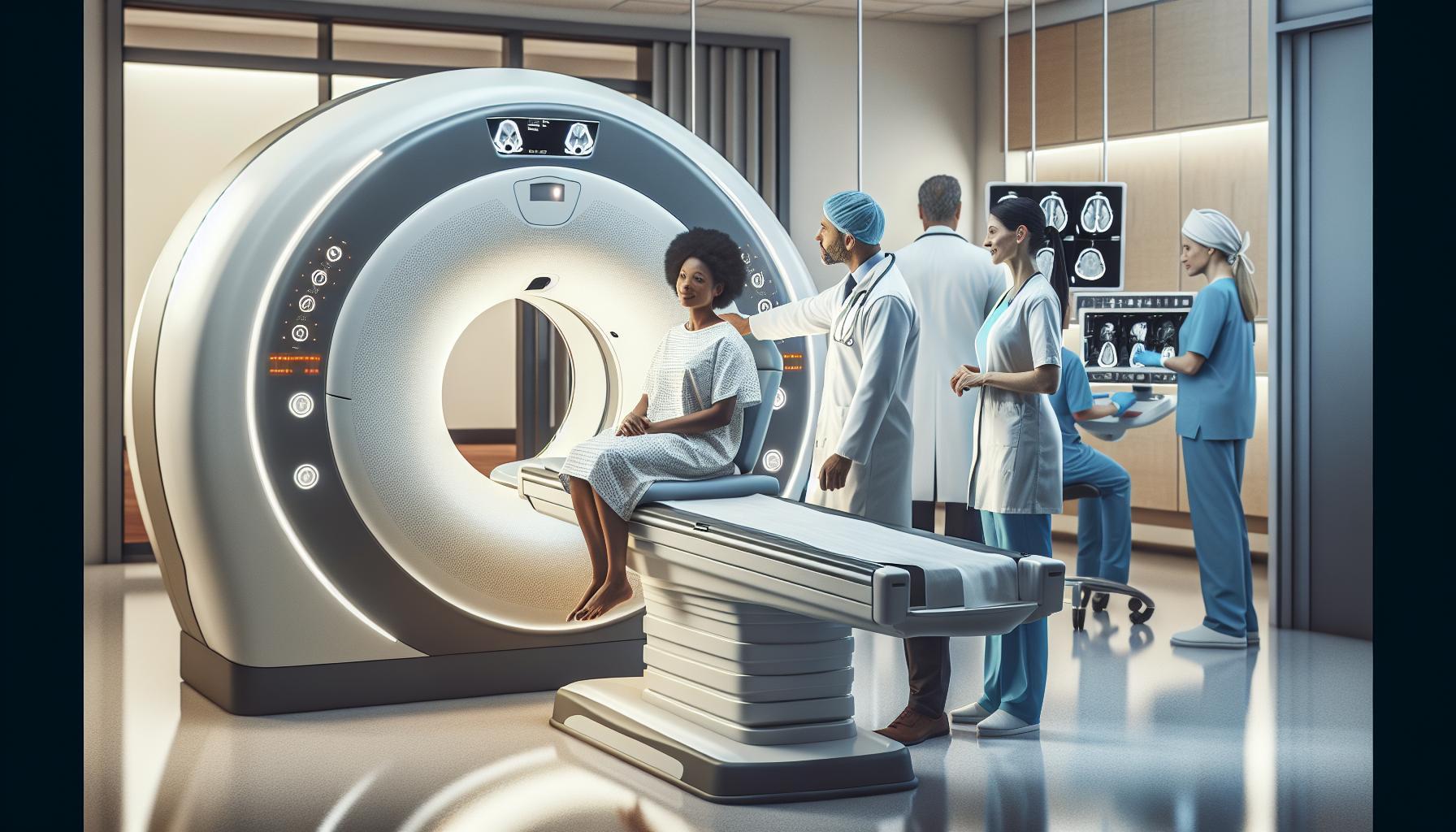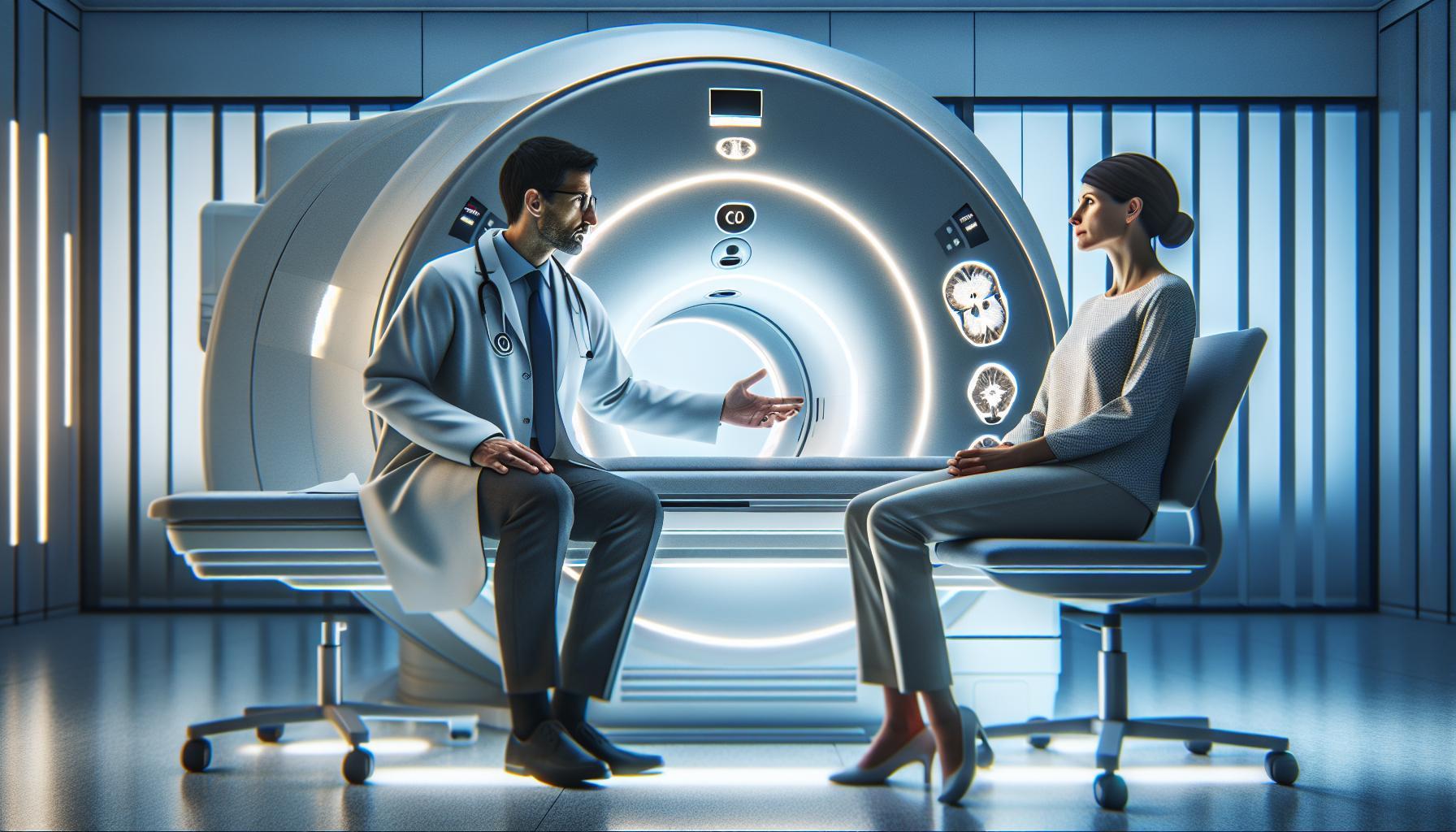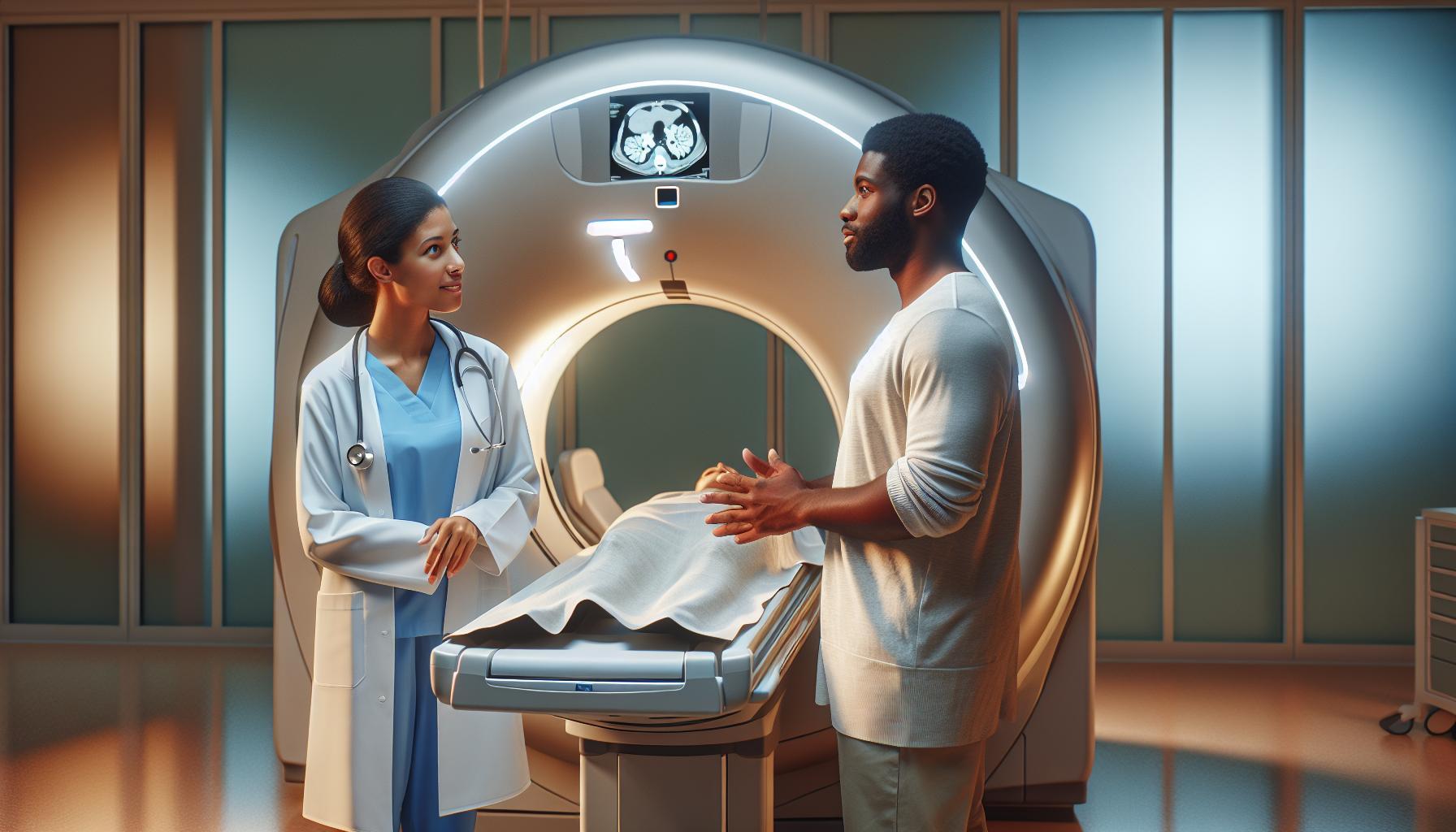Navigating the medical landscape can be daunting, especially when it comes to imaging tests like a head CT scan. Did you know that CT scans are essential for diagnosing conditions such as head injuries, tumors, or strokes? Understanding how to read your head CT results empowers you to engage in informed discussions with your healthcare provider, alleviating concerns and fostering a sense of control over your health.
In this guide, we’ll break down the basics of head CT imaging, explain what to expect during the process, and help you interpret the results in understandable terms. Whether you’re facing a medical issue or are simply curious about the procedure, this resource is designed to provide clarity and support, ensuring you feel more knowledgeable and confident every step of the way.
How Head CT Scans Work: A Simplified Overview
A head CT scan, or computed tomography scan, is a powerful diagnostic tool that provides detailed images of the structures inside the skull, including the brain, blood vessels, bones, and other tissues. It utilizes a series of X-ray images taken from different angles, which are then processed by a computer to create cross-sectional images-often referred to as slices-of the head. This technology allows healthcare providers to detect abnormalities, assess injuries, and diagnose various conditions such as tumors, strokes, and neurological disorders.
The process begins with the patient lying flat on a table that slides into the CT scanner, a large, donut-shaped machine. Once positioned, the patient may be asked to hold their breath for a few seconds while the scan is in progress. This is essential to minimize motion, ensuring the highest quality images. Advanced CT scanners may also use contrast dye, administered orally or through an intravenous line, which helps to enhance the visibility of specific areas during the scan. The entire procedure typically takes only a few minutes, making it a relatively quick and efficient process.
Patients are often concerned about radiation exposure during CT scans. It’s important to know that while CT scans do involve X-rays, the doses are carefully managed to keep them as low as possible while still producing high-quality images. Radiologists evaluate the need for the scan versus the risks involved, and they aim to provide the most informative results in the safest manner for patients. After the scan, a radiologist analyzes the images and provides a report to the referring physician, who will discuss the findings with you and suggest any further steps if necessary. Understanding these basics can help alleviate anxiety and empower you as a patient, enabling you to engage in informed discussions about your healthcare.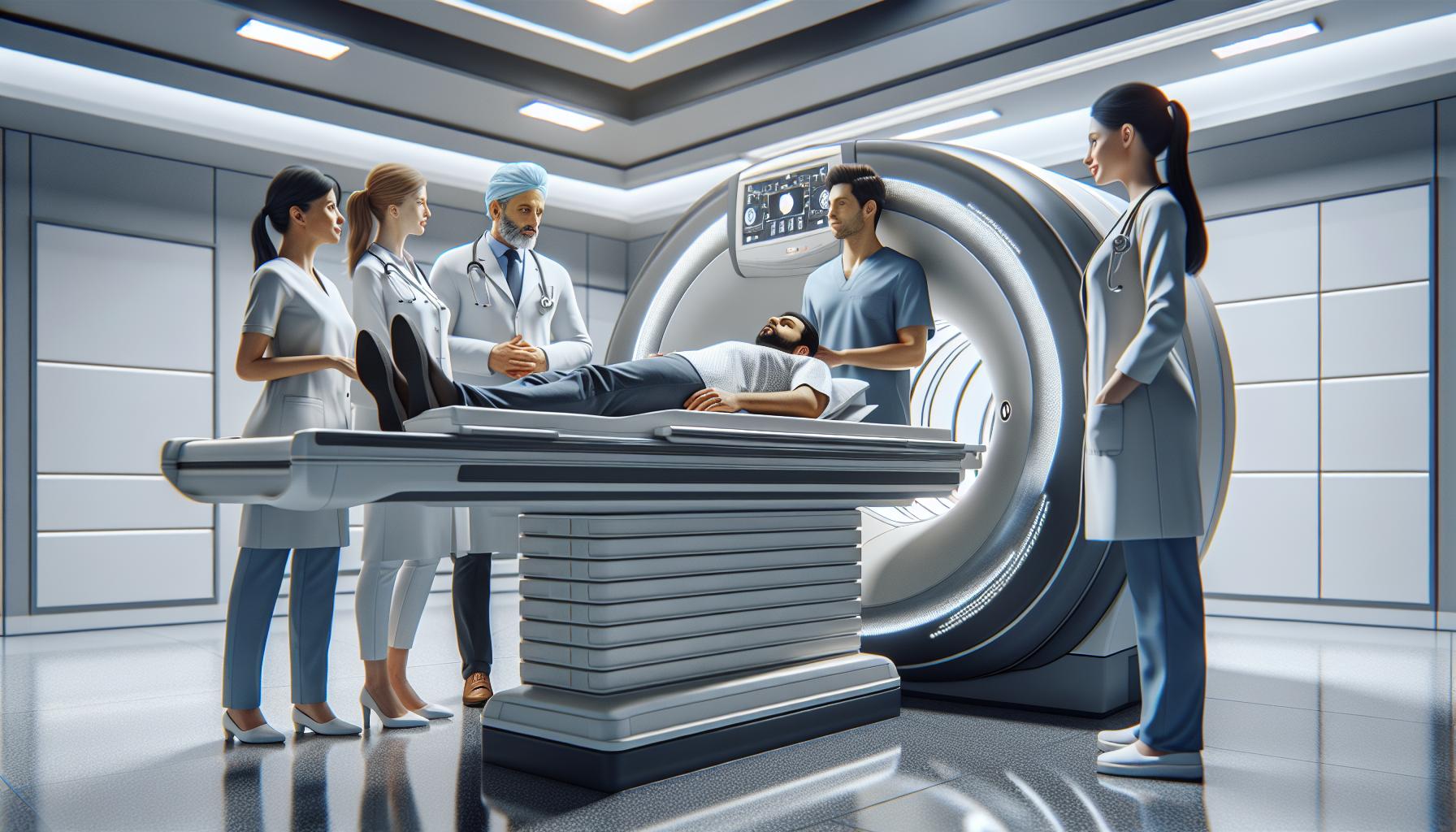
What to Expect During a Head CT Scan
Undergoing a head CT scan can be a daunting experience, especially for those unfamiliar with the process. Knowing what to expect can significantly ease anxiety and help you feel more comfortable. When you arrive for your scan, you will check in and likely be asked to change into a hospital gown to ensure there are no metal objects on your clothing that could interfere with the imaging process. It’s perfectly normal to feel nervous, but keep in mind that this imaging technique is designed to provide essential insights into your health.
Once you are taken to the imaging room, you’ll lie down on a padded table that will slide into the large, circular CT scanner. This machine might look intimidating, but it is designed for your safety and comfort. As the scan begins, the machine will make various clicking and whirring sounds, which is perfectly normal as it captures detailed images of your head from different angles. You may be asked to hold your breath briefly while the scanner is taking pictures. This action helps produce clearer images, as even slight movements can impact the quality of the scans.
For many patients, the use of contrast dye may be part of the procedure. If indicated, it will be administered via an intravenous line or taken orally. This contrast helps highlight specific areas within the brain and skull, providing more detailed and informative images for your physician. The entire process typically lasts only about 10 to 30 minutes, depending on the complexity of the images required.
After the scan, you will be free to resume your normal activities right away unless otherwise directed by your healthcare provider. The images will be evaluated by a radiologist, who will provide a report to your referring physician. They will discuss the results with you and recommend any necessary follow-up steps or treatments. Understanding these steps can empower you, helping you actively participate in your healthcare decisions. Always feel free to ask questions or express any concerns you have before the procedure; healthcare professionals are there to support and provide clarity.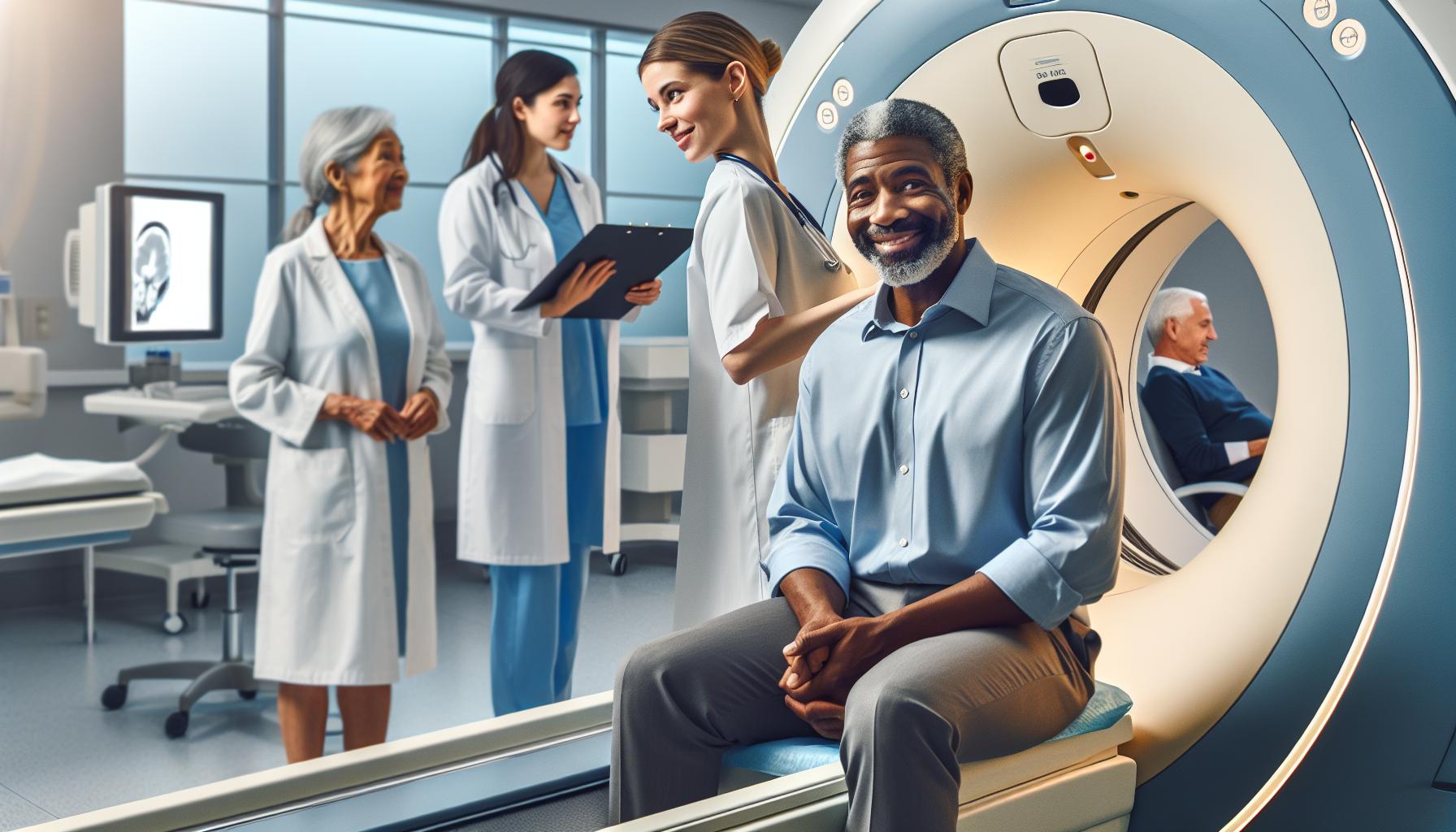
Preparing for Your Head CT: Essential Steps
Preparing for a head CT scan can feel overwhelming, but understanding the steps involved can help alleviate anxiety and ensure a smoother experience. One important factor to consider is your clothing; it’s best to wear comfortable, loose-fitting clothing that doesn’t contain any metal. This includes avoiding metal buttons, zippers, or any accessories such as jewelry, hairpins, or glasses, as these can interfere with the imaging process. Upon arrival, you’ll likely be asked to change into a hospital gown to ensure a clean environment for the scan.
It’s also crucial to inform your healthcare provider about any pre-existing conditions or allergies, especially if a contrast dye will be used during the procedure. Patients who have kidney issues or a history of allergic reactions to contrast materials should disclose this information ahead of time. If you’re required to undergo a scan with contrast, you may be instructed to refrain from eating or drinking for a few hours prior. This preparation helps reduce the risk of complications and allows for clearer visualization during the imaging procedure.
Before the CT scan, take a moment to gather your thoughts and ask any questions. It’s normal to have concerns, and talking with the medical staff can provide reassurance. For example, if you’re worried about the sounds the machine makes or the feel of the scanner, express those fears. They are trained to guide you throughout the process and can provide useful tips to keep you calm. Remember, the scan itself is quick, typically lasting only about 10 to 30 minutes, and understanding the procedure will make it feel more manageable.
Finally, consider arranging for someone to accompany you if it helps ease your nerves. Having a support person can provide comfort before and after the scan, particularly if you’re feeling anxious. By being well-informed and prepared, you can approach your head CT scan with confidence, making it a less stressful experience overall.
Understanding CT Imaging: Key Terminology Explained
Understanding how CT imaging works can demystify the process and reduce anxiety about your upcoming head scan. A CT scan, or computed tomography, harnesses X-ray technology to create detailed cross-sectional images of the body, offering a more comprehensive view than standard X-rays. This complex imaging technique can reveal important information about the structure and condition of your head, helping healthcare providers make accurate diagnoses.
When considering a head CT, it’s helpful to familiarize yourself with some key terminology:
Common Terms in CT Imaging
- Slice: Each individual image captured by the CT scanner is called a “slice.” The scanner takes numerous slices at various angles, which are then reconstructed into a comprehensive 3D representation of the head.
- Contrast Agent: Often, a contrast dye is used to enhance the visibility of certain tissues or blood vessels in the images. This liquid is administered intravenously and may help highlight areas of concern.
- Radiologist: This is a medical doctor specialized in interpreting medical images. After your scan, a radiologist will review the images and provide a report to your physician.
- Artifacts: These are distortions or anomalies that can appear in the images, often caused by movement, metal implants, or other factors. Understanding that artifacts can sometimes affect results helps put patient minds at ease.
Another important consideration is the role of the CT technician, who will operate the machine during your scan. They are skilled professionals who will guide you through the process, ensuring that you remain still and comfortable.
Embracing this knowledge can empower you to feel more in control during your head CT scan. If at any point you’re uncertain about a term or process, remember that open communication with your healthcare team is key. They are there to ensure your understanding and comfort throughout this vital diagnostic procedure.
Interpreting Head CT Results: A Patient’s Guide
When you receive your head CT results, it’s understandable to feel a mix of curiosity and apprehension. These images provide critical insights into your brain’s structure and can reveal conditions such as bleeding, tumors, or strokes. It’s essential to approach the interpretation of these results with both clarity and support from your healthcare team.
In most cases, the CT report will include clear findings such as “normal,” “abnormal,” or specific diagnoses. Here’s what to consider as you review your report:
- Tumors: If any masses are detected, the report may specify their size and location, helping your doctor determine the next steps.
- Bleeding: Terms like “hemorrhage” or “edema” alert you to potential issues with blood flow or swelling in the brain.
- Structural Abnormalities: Descriptions related to skull fractures or congenital issues will guide further evaluations.
It’s helpful to connect with your healthcare professional to discuss any complex terminology or results that you find confusing. Radiologists provide a detailed report, but the nuances of medical imaging can often lead to questions. Don’t hesitate to ask for clarification; understanding your results is crucial in making informed decisions about your healthcare. Engaging in this dialogue fosters a partnership in your health journey, giving you confidence and reassurance.
Remember, interpreting CT results accurately isn’t solely your responsibility. Your healthcare provider is there to interpret the findings within the context of your medical history, symptoms, and any additional tests that may have been performed. This holistic approach is vital in ensuring that all aspects of your health are considered before determining the appropriate management plan.
Common Uses of Head CT Scans: What They Diagnose
Head CT scans serve as a crucial diagnostic tool for various medical conditions, offering rapid imaging of the brain and surrounding structures. Understanding the common diagnoses associated with these scans can provide reassurance and clarity for patients seeking answers about their health.
These imaging studies are often employed to evaluate suspected stroke or intracranial hemorrhage. In emergency settings, a CT scan can quickly identify bleeding in the brain, which is critical for effective treatment. Additionally, trauma-related injuries, such as skull fractures or contusions, are frequently assessed using head CTs to help guide immediate care following incidents like falls or accidents.
Tumors, both benign and malignant, are another significant reason for head CT scans. The imaging can reveal the presence, size, and location of masses, which is essential for treatment planning. In cases of severe chronic headaches, CT scans help rule out structural issues like hydrocephalus (accumulation of cerebrospinal fluid) or any abnormalities that could be causing discomfort.
Beyond acute conditions, head CT scans are valuable for evaluating infections such as abscesses or encephalitis, as well as for post-operative monitoring following neurosurgery. While the findings from a head CT may inform diagnoses, always discuss the results with a healthcare provider, who can contextualize the images within your unique medical history and symptoms. This partnership ensures you receive the most accurate interpretation and informed next steps regarding your health.
CT Scan Safety: Risks and Considerations
Undergoing a head CT scan can understandably raise concerns about safety, particularly regarding radiation exposure. It’s essential to remember that while CT scans utilize X-ray technology to produce detailed images, the benefits of quickly diagnosing serious medical conditions often outweigh the potential risks associated with radiation. Each scan is carefully calibrated to minimize exposure, ensuring that it is as safe as possible for patients.
Understanding Radiation Risks
The amount of radiation from a single head CT scan is relatively low and comparable to the amount a person naturally receives from the environment over a few years. However, repeated exposure can accumulate, which is why healthcare providers are diligent in determining when a CT scan is truly necessary. In most cases, the clarity a CT scan provides in diagnosing conditions like strokes, tumors, or head injuries justifies its use. Discussing your medical history and potential risks with your doctor is critical to ensure that a CT scan is appropriate for your particular situation.
Considerations for Specific Populations
Certain populations, such as pregnant women or young children, may require extra precautions due to their increased sensitivity to radiation. For pregnant women, alternative imaging methods that do not use ionizing radiation, like ultrasound or MRI, may be recommended when appropriate. If a CT scan is necessary, specialized equipment and techniques can help minimize radiation exposure to the fetus. Children, being more vulnerable to the effects of radiation, often necessitate adjusted protocols to ensure their safety.
Steps to Enhance Safety During Your Scan
Prior to undergoing a CT scan, consider the following actions to enhance your safety:
- Communicate openly: Inform your medical team about any previous imaging exams, especially CT scans, to avoid unnecessary repetition.
- Discuss alternatives: Ask your provider if other imaging options are available that may pose fewer risks while still providing the necessary diagnostic information.
- Follow prep instructions: Adhere to any guidelines given prior to your scan, such as fasting or avoiding certain medications, to ensure the best results.
In conclusion, while the notion of radiation exposure may cause anxiety, understanding the safety protocols and the medical necessity of head CT scans can offer a sense of reassurance. Always consult with your healthcare provider about any concerns or questions you may have; their expertise will help guide you toward the safest choices for your health.
How to Read Your Head CT Report
Understanding your head CT report can be both enlightening and overwhelming, especially when navigating medical jargon. Each report provides detailed information about the images taken during your scan, outlining the findings in a way that healthcare providers can use to diagnose potential issues. Familiarizing yourself with the common elements of a CT report will empower you to engage more effectively with your healthcare provider.
A typical head CT report begins with patient information and study details, which includes the type of scan, the date it was performed, and sometimes the reason for the scan. Following that, the report will often feature a comparison section that allows the radiologist to reference previous scans, if available. It’s helpful to note if this scan was done for follow-up purposes, as it can provide context for changes that may be observed.
The core of the report consists of detailed findings, where radiologists describe what they see, such as the condition of brain structures, blood vessels, and any abnormalities. Terms like “lesion”, “mass”, or “hemorrhage” may appear. If you encounter these technical terms, don’t hesitate to ask your healthcare team to clarify what they mean and their implications. Additionally, many reports will include an impression section that summarizes the findings and suggests potential diagnoses. This part is crucial, as it provides an overall picture of your head health and indicates whether further testing or treatment is needed.
To help you interpret the information effectively, consider these steps:
- Ask questions: If there is something you don’t understand, reach out to your doctor for clarification.
- Request a copy: Keep a personal record of your report for future reference and consultations.
- Prepare for discussions: Jot down any related symptoms or health changes since your last visit, as this information can be pertinent to your overall assessment.
Remember, while reading your head CT report can be informative, it is essential to consult with a healthcare professional to fully understand the results and any next steps you may need to take. They are equipped to integrate the report’s findings with your overall health picture, helping you make informed decisions about your care.
Follow-Up Steps After Your Head CT Scan
After undergoing a head CT scan, it’s common to feel a mix of anticipation and anxiety as you await your results. The wait can be stressful, but understanding your next steps can help alleviate some of that concern. Clear communication with your healthcare provider is key to navigating this period effectively and can empower you to engage actively in your health care.
Upon completion of your CT scan, the images will be sent to a radiologist for evaluation. This professional will analyze your scans and provide a report detailing the findings. Typically, the report will be shared with your primary care physician or the specialist who ordered the scan. Make sure to follow up with your healthcare provider to discuss the results. Consider scheduling an appointment shortly after your scan to ensure you have ample time to review and address any concerns that arise from the report.
During your follow-up appointment, take the opportunity to ask specific questions. You might want to inquire about the findings in your report, such as what they mean for your health and any implications for further testing or treatment. If the radiologist found any abnormalities, discussing the potential next steps is vital. It can also be helpful to bring a list of any symptoms you’ve experienced or new changes in your health since your last visit.
Additionally, it’s important to explore what lifestyle changes or preventive measures you may need to adopt based on the findings from your scan. This could include adjustments in diet, exercise, or medication. Remember, your follow-up appointment is a chance for you to advocate for your health. Don’t hesitate to express any concerns or feelings you may have regarding the process and outcomes; your doctor is there to support you.
Lastly, keep a patient record of your scan and results. This can help you track changes in your condition over time and will be beneficial for any future medical consultations. By taking these proactive steps, you’re not only ensuring that you remain informed but also actively participating in your healthcare journey, which is vital for your peace of mind and well-being.
Cost of Head CT Scans: What You Should Know
Understanding the financial aspects of a head CT scan is crucial for patients preparing for this important diagnostic tool. The average cost of a head CT scan can vary significantly based on several factors, including location, facility type, and whether you have health insurance. Typically, without insurance, patients might expect to pay anywhere from $300 to $3,000 depending on these variables.
When considering costs, it’s helpful to keep in mind the following:
- Insurance Coverage: If you have health insurance, check with your provider about coverage for CT scans, including any copays or deductibles. Pre-authorization may be required, so it’s wise to confirm these details in advance.
- Facility Type: Costs can differ between hospital outpatient centers and independent imaging clinics. Independent facilities often charge less for the same services, so it’s beneficial to shop around.
- Geographical Location: Prices may vary significantly from one region to another, with urban centers typically having higher costs compared to rural areas.
- Additional Fees: Don’t forget potential extra costs like radiologist fees for interpreting the scan results. These can add an additional several hundred dollars to your total bill.
To navigate costs effectively, consider discussing financial options with your healthcare provider’s office. Many places offer payment plans or financial assistance programs to help manage costs, especially if you are uninsured or underinsured.
Keep in mind that while costs are an important consideration, the primary focus should be on obtaining a proper diagnosis and care. A head CT scan can provide invaluable information about your health, making it a worthwhile investment in your well-being. Always feel empowered to ask questions and seek clarity about pricing before moving forward with the procedure. This proactive approach not only helps alleviate financial anxiety but also encourages a collaborative relationship with your healthcare team.
Questions to Ask Your Doctor About Head CTs
Understanding the ins and outs of a head CT scan can seem daunting, but asking the right questions can empower you with the knowledge you need for a more positive experience. It’s essential to engage your doctor in an open conversation to address any concerns you may have. Start by asking about the purpose of the scan, such as whether it’s being used to evaluate specific symptoms like headaches, dizziness, or trauma. Knowing the reason behind the scan can alleviate anxiety and help you understand the significance of the procedure.
It’s also wise to inquire about the procedure itself. You might ask, “What will happen during the scan?” and “How long will it take?” This information can help you mentally prepare for the appointment. If you have any concerns about the use of contrast dye, particularly if you have allergies or pre-existing conditions, be sure to discuss these with your healthcare provider. Understanding any potential side effects can lessen apprehension.
Another critical aspect to address is the interpretation of the results. Asking, “Who will interpret my CT scan, and when can I expect the results?” can set proper expectations for follow-up communication. If the results indicate a need for further testing or treatment, inquire about what the next steps would be and if there are any lifestyle changes you should consider in the meantime.
Lastly, consider discussing the safety of CT scans. Inquire about the risks associated with radiation exposure and whether there are alternative imaging methods available. This proactive approach not only ensures that you are fully informed about the procedure but also fosters a collaborative relationship with your healthcare provider, paving the way for a thorough and comfortable diagnostic process.
Resources for Patients: Further Information and Support
Navigating the complexities surrounding head CT scans can be challenging, but comprehensive resources are available to help make this process more manageable and less daunting. Various organizations, including hospitals, imaging centers, and healthcare institutions, often provide valuable educational materials that can enhance your understanding of the procedure, the technology involved, and the interpretive process following the scan. Utilizing these resources can empower you and help alleviate concerns you might have.
Consider exploring the following resources for further education and support:
Educational Websites
- The American College of Radiology (ACR): Offers extensive information about different imaging modalities, including a section dedicated to understanding CT scans.
- The Radiological Society of North America (RSNA): Provides patient-centric content that explains imaging procedures and results in simple language.
- Healthline and Mayo Clinic: Both provide accessible articles on CT scans, their uses, preparation, and post-scan procedures.
Support Groups and Forums
Engaging with online communities can be incredibly beneficial. Platforms like Inspire or specific Facebook groups allow patients to share their experiences and gain emotional support. Discussing feelings or uncertainties with others who have been through similar situations can offer reassurance and valuable insights.
Consult Your Healthcare Team
Never underestimate the power of asking questions. Your healthcare provider is your best resource for personalized guidance. Whether it’s understanding technical jargon found in your report or discussing possible outcomes, open conversation is key. Do not hesitate to ask for additional information or clarification – your comfort and understanding should always be a priority.
Pre- and Post-Scan Considerations
Be proactive in preparing for your scan. Familiarize yourself with the preparation guidelines specific to your situation, which may include dietary restrictions or medication considerations. Similarly, understanding follow-up steps and when to expect results is crucial in alleviating post-scan anxiety. Knowing that your healthcare provider is always available for interpretation and discussion will further support your peace of mind.
Utilizing these resources equips you to engage more meaningfully in your healthcare journey. Staying informed and connected with healthcare professionals can significantly enhance your experience surrounding head CT scans and any subsequent treatment plans.
Frequently asked questions
Q: How long does it take to get results from a head CT scan?
A: Results from a head CT scan are typically available within a few hours to a day, depending on the facility. Radiologists will evaluate the images and send a report to your doctor, who will discuss the findings with you. For detailed guidance, refer to the “Understanding CT Imaging: Key Terminology Explained” section of our article.
Q: What are the common signs that indicate a head CT scan is necessary?
A: Common signs that a head CT scan may be necessary include severe headaches, confusion, fainting, or head trauma. If you experience any of these symptoms, consult your physician for a proper recommendation. More details can be found in the “Common Uses of Head CT Scans: What They Diagnose” section of the article.
Q: Can I eat or drink before a head CT scan?
A: Generally, it is recommended to avoid food and drink for a few hours before a head CT scan, especially if contrast dye is used. Always follow specific instructions provided by your healthcare provider. For more about preparation steps, see the “Preparing for Your Head CT: Essential Steps” section.
Q: How can I understand the images on my head CT scan?
A: Understanding CT images can be complex, but you can ask your doctor to explain the key areas and findings. They can help you interpret results in relation to symptoms. For a deeper understanding, the “Interpreting Head CT Results: A Patient’s Guide” section is particularly useful.
Q: Are there alternative imaging techniques to a head CT scan?
A: Yes, alternatives to head CT scans include MRI and ultrasound. Each method has its advantages and is chosen based on specific medical needs. Consult your doctor for personalized recommendations. More about imaging techniques is discussed in “How Head CT Scans Work: A Simplified Overview.”
Q: What should I do if I have concerns before or after my head CT scan?
A: If you have any concerns before or after your head CT scan, do not hesitate to contact your healthcare team. They can provide support and answer questions to ease your worries. For additional questions, refer to “Questions to Ask Your Doctor About Head CTs.”
Q: What types of blood tests are done before a head CT scan?
A: Generally, blood tests are not routinely performed before a head CT scan unless indicated by your doctor based on individual health factors. It’s best to consult your healthcare provider regarding what to expect. For further information on safety, check the “CT Scan Safety: Risks and Considerations” section.
Q: Why might I need a follow-up appointment after a head CT scan?
A: A follow-up appointment is crucial to discuss results, review treatment options, and address any ongoing symptoms. Your doctor will tailor the follow-up based on the CT findings. For follow-up steps, see the “Follow-Up Steps After Your Head CT Scan” section of the article.
To Wrap It Up
Understanding how to read a head CT can empower you to make informed discussions with your healthcare provider about your results. Remember, each scan is unique, and the insights shared in this guide are just the beginning. If you feel uncertain or have questions about your own situation, don’t hesitate to consult your doctor for personalized advice and clarity.
For further exploration, check out our articles on “CT Scans: What to Expect” and “Understanding Imaging Results” to deepen your knowledge. Stay informed by signing up for our newsletter, where we share valuable insights into medical imaging and health tips every week.
Your health matters, and being proactive in understanding your medical imaging can significantly enhance your peace of mind. Share your thoughts or questions in the comments below, and keep exploring to empower your health journey!

